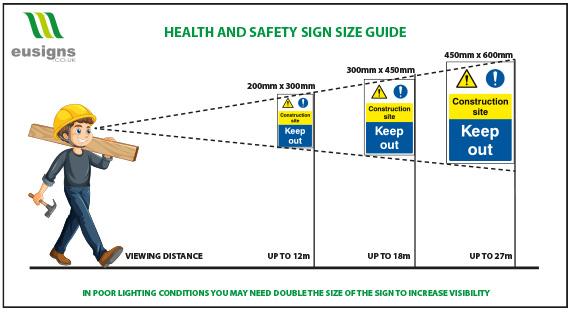Return to previous page
Picking sign sizes by “A-paper” alone is lazy and often wrong. Instead, size is driven by viewing distance, illumination, environment and sign type (pictogram-only vs text). Therefore, if you want your signage to do its job – and to stand up in an audit – you must size from first principles set out in UK and European guidance and standards.
Before you even think about millimetres, gather the basics. First, define the longest viewing distance at which the message must be understood (not just “visible”). Second, note the illumination type: internally lit, externally lit, photoluminescent, or ambient only. Third, describe the environmental difficulty: glare, smoke, dust, clutter, moving plant, or curved sightlines. Finally, confirm the sign content: symbol-only or symbol plus supplementary text/arrow. Because each factor affects legibility, you will oversize or duplicate signs where conditions are poor.
European design principles treat the sign (or its symbol field) as a visual object whose minimum height scales with how far away it must be read. In practice, we use a simple relationship: H = L ÷ Z (equivalently, L = Z × H), where H is the sign or symbol-field height, L is the viewing distance, and Z is a distance factor that depends on illumination and context. Consequently, you choose a conservative Z, compute the minimum H, and then pick the next size up in your range. Because different standards define “H” slightly differently (overall sign height vs. symbol field vs. x-height for text), always check which dimension your calculation refers to, and size your finished panel accordingly.

Health and safety sign size guide
For externally illuminated or ambient-lit signs, many authorities use Z ≈ 100–130; for internally illuminated signs, Z ≈ 200. These factors come from European design rules for safety/escape signs and are echoed in UK guidance. Therefore, as a quick, conservative rule on normal workplaces: assume Z = 100 for externally lit signs. If conditions are poor—or if the sign carries text—size up.
Example 1: Plant room door, 12 m approach, externally lit. If you choose Z = 100, you need H ≈ 120 mm for the symbol field/overall sign height (depending on the standard you’re following). In other words, a small “A5-ish” panel is usually too small. Therefore, select the next size that delivers at least that visual height and mount it at eye level free of obstructions.
Example 2: Long corridor, 25 m sightline, internally illuminated escape sign. Using Z = 200, you need H ≈ 125 mm for the sign height of the illuminated unit. However, if smoke or glare is likely, increase the size or repeat the sign to keep legibility high and decision times low.
Example 3: Outdoor hoarding with moving plant, 30 m viewing distance. Start with Z = 100 so H ≈ 300 mm. Nevertheless, because drivers have shorter glance times, step up again or repeat at intervals, rather than gambling on a single oversized panel.
Health and safety sign icon size guide
Symbols communicate faster than words, but supplementary text can still be essential. In that case, the x-height of the text must also be sized for the viewing distance. A common, serviceable rule of thumb indoors is letter height ≈ L ÷ 200 (in the same units), though you should adjust upwards for difficult conditions. Moreover, maintain clear hierarchy: the standard pictogram should remain visually dominant, with concise text beneath or beside it.
Escape route and emergency lighting signs follow illumination-specific rules; internally lit products can legitimately reach further for the same size, which is why they use higher distance factors. Additionally, high-hazard industrial areas (dust, steam, moving plant) justify aggressive oversizing and tighter repeat spacing. Similarly, public-facing premises with mixed audiences (children, visitors, non-native speakers) benefit from larger symbols and fewer words. Finally, road traffic signs are governed by completely different regulations—do not borrow their numbers for workplace safety boards.
If you size safety signs by paper habits, you will under-specify and under-perform. However, if you size from viewing distance and illumination—using simple, defensible formulas—you’ll achieve faster recognition, fewer mistakes and cleaner audits. Therefore, stop asking “Is A4 enough?” and start asking “What distance must this be understood from, under these conditions?” Choose the factor, do the maths, and then make the sign impossible to miss.
Click Here to Download Safety Sign Size Calculator.
Best Selling Products from Our Shop:
From Our Blog: